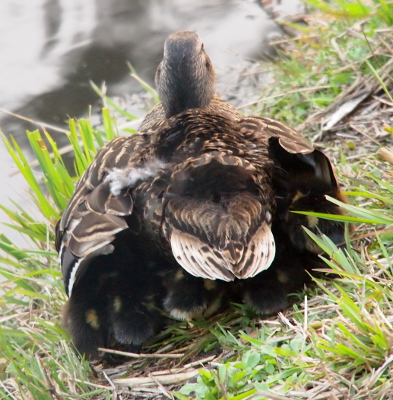Many mallard pairs raised their little ones within a short radius of an extended-stay hotel in Jacksonville, Florida. These first two pages show how the fuzzy little brown and yellow ones grew into their mature colors. Pages 3 and 4 show wing growth and the fifth page documents eclipse plumage changes which happen each year in the male mallards.
Page 1 of 5
- - - - - - - - - - - - -
It all starts with the eggs. (These never hatched.)
![[One dirty-looking white egg in a depression of leaves and grass in the ground. Another egg is about six inches away atop the grass.]](Photo-mallards/1223 - eggs 2.jpg)
Momma mallard with her little ones who are only a day or two old
![[A female mallard swims from left to right in shallow water (grass is sticking up through it) while her four little ones swim in a straight line behind her.]](Photo-mallards/1113 - mallard family of 4 12.jpg)
The first few days out of the shell Mom protects and keeps the little ones warm by covering them with her wings. There are 11 little ones in there getting settled for the night.

Mallards often sleep with their bill tucked under a wing. Apparently it's a natural sleeping position as this four-day-old duckling has its bill tucked behind its tiny wing.
![[Side view of a duckling sitting on the ground with its bill mostly covered by the near wing which sticks out from its side is a small arc. Its eyes are closed making the brown-striped yellow eyelid visible. The stripe on the eyelid lines up with the brown stripe across its face.]](Photo-mallards/20150307 - mallard family of 12-2 17.jpg)
Ducklings are bundles of energy when this size.
![[Five ducklings each going a different direction in the shallow water.]](Photo-mallards/0607 - mallard family of 7yy 4.jpg)
This duckling is approximately 7 to 10 days old.
![[Side view of a duckling sitting in the grass and looking at the camera. It's fur is spiked as if it was recently in the water.]](Photo-mallards/0503 - mallard family of 8(mom4) 5.jpg)
These ducklings are also approximately 10 days old. Mom left with Dad for a short while leaving these ones who had been huddled under her exposed to the elements. Vultures commonly fly over this area so that's probably what has their attention.
![[Eight ducklings are huddled together on the grass. Their yellow heads with the brown stripe going through the eye area are visible while their brown bodies mostly blend into the ground. All the heads are tilted upward and they are looking at something overhead.]](Photo-mallards/20150311 - mallard family of 12-4 7.jpg)
The ducklings continue to get bigger even as they remain brown and yellow-beige.
![[A very close view of a duckling looking straight at the camera. Its big lump under its neck that all little ones have (to help them float) is prominent. The duckling walks on concrete with white lines on it.]](Photo-mallards/20150605 - mallard family of 8-2 4.jpg)
Continue to watch the ducklings mature. (page 2 of 5)
All photos © S. M. Garver